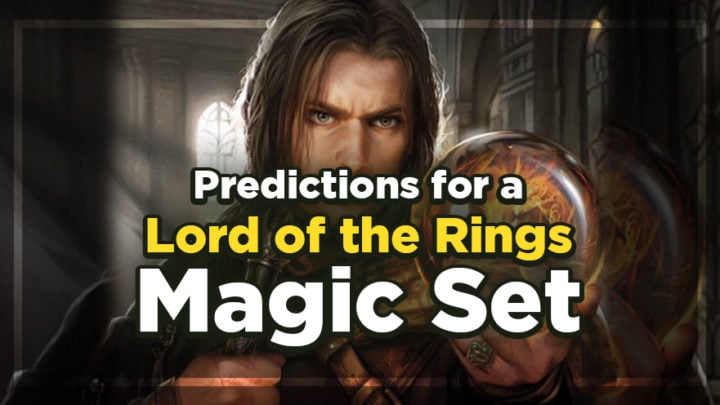I’m a huge fan of Magic: the Gathering, but I’m an even bigger fan of Lord of the Rings. When I heard that we might get a LotR-themed expansion, I couldn’t resist brainstorming how that might look. Join me today as I explore how that set might shape up — and stick around for my LotR Commander deck at the end!
IT’S LIKE IN THE GREAT STORIES, MR. FRODO
First up, how would Lord of the Rings fit into the Magic universe? Well, it’s easier to imagine than the Warhammer 40k crossover, that’s for sure. LotR is a traditional high fantasy story — no, the traditional high fantasy story, and for all intents and purposes, the precursor to much of the media we have today.
Middle-earth feels historical more than fictional, and that’s because the sense of magic and wonder is, in large part, grounded. Aside from the occasional showing of power from some of the ancient beings of Middle-earth like The Balrog, or Gandalf, the setting feels real and tangible. Tolkien poured countless hours into worldbuilding, and if not for his love of language and family trees, Middle-earth as we know it would not exist.
In part, the film adaptation builds on this with its excellent props department, whose work on armor, weapons and “bigatures” gives the film a real sense of place. All in all, the biggest point of contention for fitting into the Magic universe is probably the fact that the plane of Middle-earth feels decidedly un-Magic.
Mechanically, this can be easily navigated — the instants and sorceries will likely depict feats of battle or preparations, much like some of the cards from grittier sets like Khans of Tarkir. Beyond that, though, it’s Middle-earth’s place in the Multiverse that is most up for debate.
I know I’m not alone in hating the idea of Jace & co planeswalking into the events of Lord of the Rings, and so I don’t think it’s too much to hope that this set might be self-contained and even function as a booster innovation product like Battlebond or Conspiracy. The idea of this expansion being at the spearhead of a new product range, Universes Beyond, hearkens back to the original vision of Richard Garfield — the deckmaster system. This set up Magic originally as a framework, rather than the sole IP, with the opportunity to use that framework for limitless possibilities. We could well be seeing that put into practice now.
Before we get stuck into what we might see from the set itself, I’d also like to theorize that we will likely only see cards from The Lord of the Rings, and not The Hobbit. There are already issues cramming too much lore into one set when it comes to Magic sets themselves, so I find it unlikely they’ll try and fit that many references into one set. Beyond that, The Hobbit wasn’t very well received, and anyone making a product will take that into consideration.
For what it’s worth, I also think this set will draw more inspiration from the Lord of the Rings movies than the books. The Amazon show on the horizon is likely to benefit from a tie-in to the established franchises, and it wouldn’t surprise me if we see a release in a similar window.
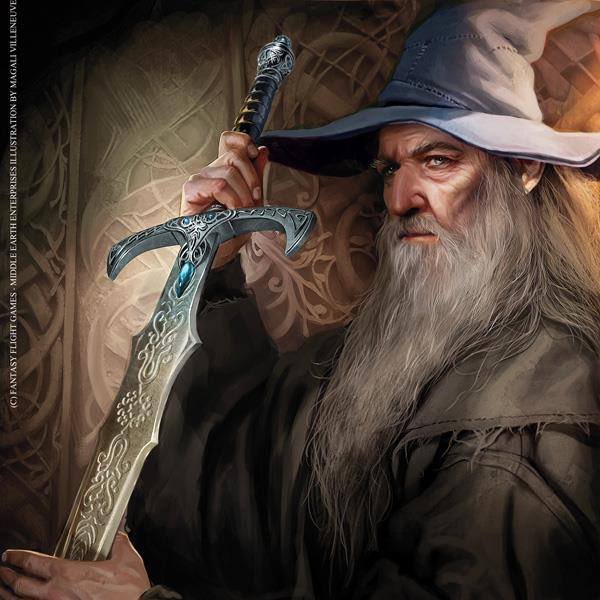
FOR I AM SARUMAN, OF MANY COLORS
When it comes to a LotR expansion, one of the first things that comes to mind for me is the colors in the set. I feel like a LotR set would be well-suited to the Shards from Alara — a color theme we haven’t seen for quite some time.
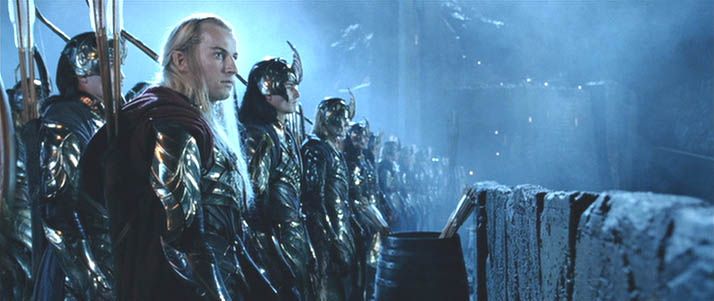
Bant
Bant seems like the shard that would encompass both the wisest allies, like Gandalf and Elrond, but also the realms of Rivendell and Lothlorien, which would probably lean more blue-white and green-white, respectively.
It’s not out of the question that some of the other characters and factions might flirt with Bant, but it feels like one of the strongest identities to tie to the Elves, and the “old” magic of Middle-earth.
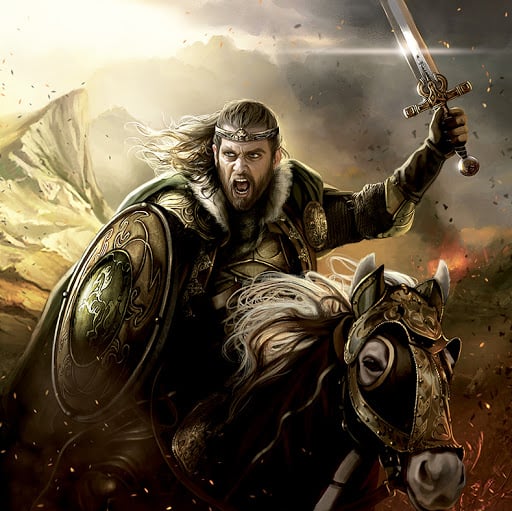
Naya
Naya, meanwhile, is for the world of Men, in which we must now place our hope. The passion, courage and virility of red is perfect for the mortal race of Men, and can be seen in the sheer determination to defeat the forces of evil. Great heroes like Theoden and Aragorn are predominantly in the Naya shard, with the realms of Gondor and Rohan leaning red-white and green-white, respectively.
There’s no reason these colors can’t overlap with the Bant ones, either, and some of the mechanical themes could easily be shared between the factions given their shared custody of green and white.
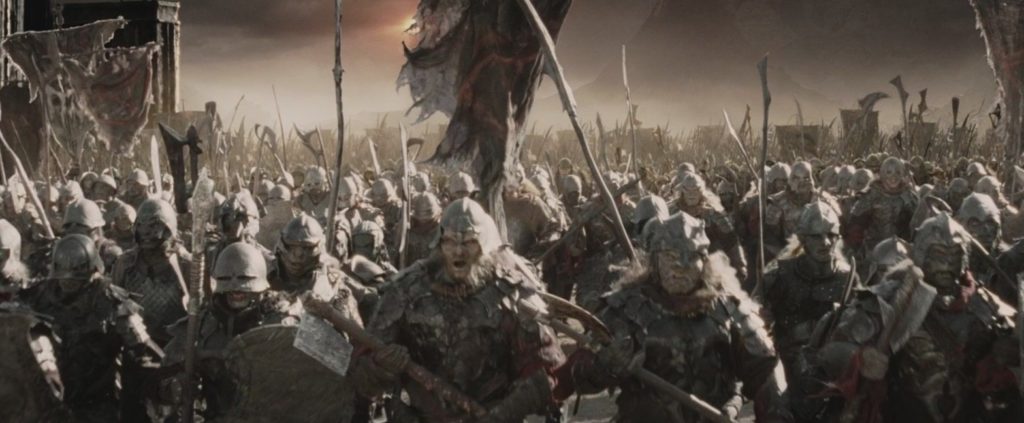
Grixis
Grixis, then, would represent the forces of Mordor. Along with the crueler sides of red and black, the will of Sauron’s cunning and desire for dominion accounts for the blue. It seems obvious to ascribe Grixis to the forces of evil, but it works for a reason.
The many races of Men that ally with Sauron can easily swing black or red, and the relentless ethereal might of the Nazgul feels right on point for blue-black.
There’s also the fact that Sauron is the creator of the rings, and artifice is very much in the wheelhouse of red and blue.

Esper
Esper, then, is an ally of Grixis, and must have some overlap to keep things balanced. It makes sense for Esper to be the faction of Isengard. Who now has the strength to stand against the armies of Isengard and Mordor?
Saruman is known for his machinations against Rohan, and his sowing the seeds of animosity between the lesser-tribes of the region against the house of Theoden, which feels super blue-black.
Isengard also meddles in the natural way of things, creating the fearsome Uruk-hai. Saruman’s subversion of the natural order and love of industry feels very Esper, and the white aspect of the identity comes from his belief in his own righteousness and power — the perfect white villain.
Besides, crows in Magic are usually blue and black, and we have to have the crebain, right?

Jund
And that leaves Jund. Jund is fantastically versatile for filling the rest of the main story beats and factions in Middle-earth, and rounds things out nicely. From the Dwarves of the Iron Hills and Erebor who lean red, to the green-black Elves of Mirkwood, to the black-red Goblins of the Misty Mountains, and even the legendary beasts and monsters, like Shelob; it all fits under Jund.
This would balance out a draft environment nicely, with some crossover of tribal identities and mechanics between the other wedges, and a general “stompy” theme. Perfect.
RETURNING MECHANICS
Visiting Middle-earth feels like it’ll be a lot like visiting Dominaria. There’s a rich and vibrant history, with countless tales of valor and villainy to recount. As such, I can see the set taking a lot from what made Dominaria excellent, and that starts with the mechanics.

First up, the set will likely have a “legendary matters” theme, given there are so many heroes and villains to include. From the lofty rares and mythics of the Fellowship of the Ring, down to uncommons that might include Grimbold, Beregond and Haldir, there’s a wealth of characters to draw from.
To balance out some of the forces of good, I can see us delving into the lore from the films to bring the likes of Lurtz and Shagrat to life.
Next, I think sagas will show up, as they have now cemented themselves as the most elegant way to convey story beats. There are a lot of epic moments in the trilogy, and concentrating them into recognizable sagas would be easy: imagine cards like “Ride of the Rohirrim” or “The Nine Cross the River Isen.”
With sagas and legendary creatures showing up, it makes sense to reward historic. Historic gives an effect based on sagas, legendary cards, and artifacts, and it’s not a stretch to imagine this set would include a lot of artifacts, too. From the reforged shards of Narsil to the gifts given to the Fellowship, the Noldorin daggers to the Palantíri, and the Rings of Power themselves — there’s a lot of potential for artifacts.
Beyond those three, it’s anyone’s guess, but I’ve been through the list of available mechanics and keywords to pick out what seems the most likely:
- Battlecry – A “Go Wide” strategy is likely given the huge armies and battles in the series, and battlecry is a way to help break stalemates.
- Annihilator – While it can be a “feel-bad” mechanic in a lot of ways, annihilator can really drive home the sheer destructive power of some of the more great and terrible creatures of Middle-earth. Think Sauron, Trolls, Mûmakil, Shelob, The Balrog — even the likes of Glorfindel.
- Equipment Matters / Metalcraft – This one is a little less likely, but if the set opts to use artifacts for many of the relics and weapons of the Third Age, then metalcraft or other equipment payoffs are mechanics that could work.
- Convoke – If we’re making tokens and going wide, Convoke is a reasonable shout. This can help to convey the payoff of working together against the odds, in the face of despair — a key facet of Tolkien’s work.
- Amass/Populate – I can’t see amass and populate in the same set, but stranger things have happened. Amass is the perfect keyword to bring back for a set about large battles, and can help to visualize the growing strength and larger armies without the need for masses of tokens. It’s perfect for Goblins and Orcs, but could easily be adapted for Human Soldiers, too.
- Allies/Rally – With Elves and Men working together (at least in the films), and Rohan and Gondor and its Fiefdoms working together, it makes sense for the Ally creature type to make a return. Turning the tide in battle by making a rallying call is very LotR, and this could also be a good way to break parity in combat in a set that’s likely to be very combat-heavy.
- Fateful Hour – A mechanic from Dark Ascension that probably didn’t get the cards it deserved, fateful hour is a flavorful way to include instants and sorceries in a set that will likely be pretty muted when it comes to literal magic.
- Miracle – Miracle, on the other hand, is arguably the more popular mechanic, and might be the better option. We could see removal spells represented by timely flourishes in combat, and token spells that signal the arrival of reinforcements.
- Wither/Persist – Wither is a slam-dunk for the damage caused by a Morgul Blade, or the continued assault from Trolls and Uruk-hai berserkers. Persist, on the other hand, can epitomize the notion of not being able to take down units quickly due to their sheer perseverance.
- Bolster/Support – It’s unlikely this would be in the same set as wither/persist, for starters. But bolster or support would make a lot of sense and would also be a nice, easy mechanic to introduce people new to Magic to the game.
- Explore – This would tie in nicely with other +1+1 counter abilities. It also helps smooth out land drops for Limited and is emblematic of the journeys across Middle-earth.
It’s possible Wizards creates a new mechanic or two that’s befitting of Middle-earth, but I think it’s likely we see returning mechanics, for the most part. And as for the cards themselves? I think, barring the occasional reprint of a fitting card — like Wood Elves, or Kill Shot — we will mostly see mechanically unique cards.
BUT WHAT ABOUT COMMANDER? WE’VE ALREADY HAD IT
It seems as good a time as any to share my Lord of the Rings: Return of the King Commander deck with you today, as it’s likely that a lot of the deck ends up being edited and re-jigged by the time the expansion hits.
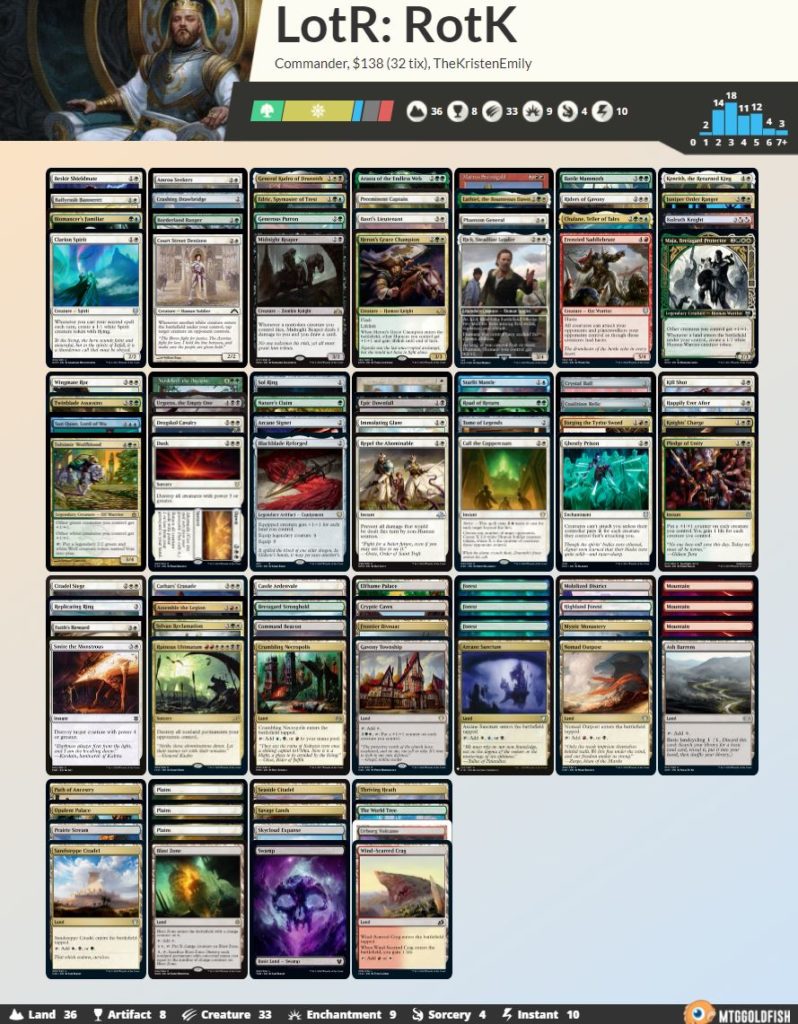
This has been a passion project of mine for a while, and Kaldheim has offered a lot of really cool cards to round out the deck. It sits firmly in the janky region, with most of the cards in the deck chosen for flavor rather than function — though I have weaved a little synergy throughout in order for it to still be able to play a game.
I don’t have the space to go into each reference here, though you will be able to find them on the decklist page. Instead, I’ll share a few of the cuter synergies and picks.
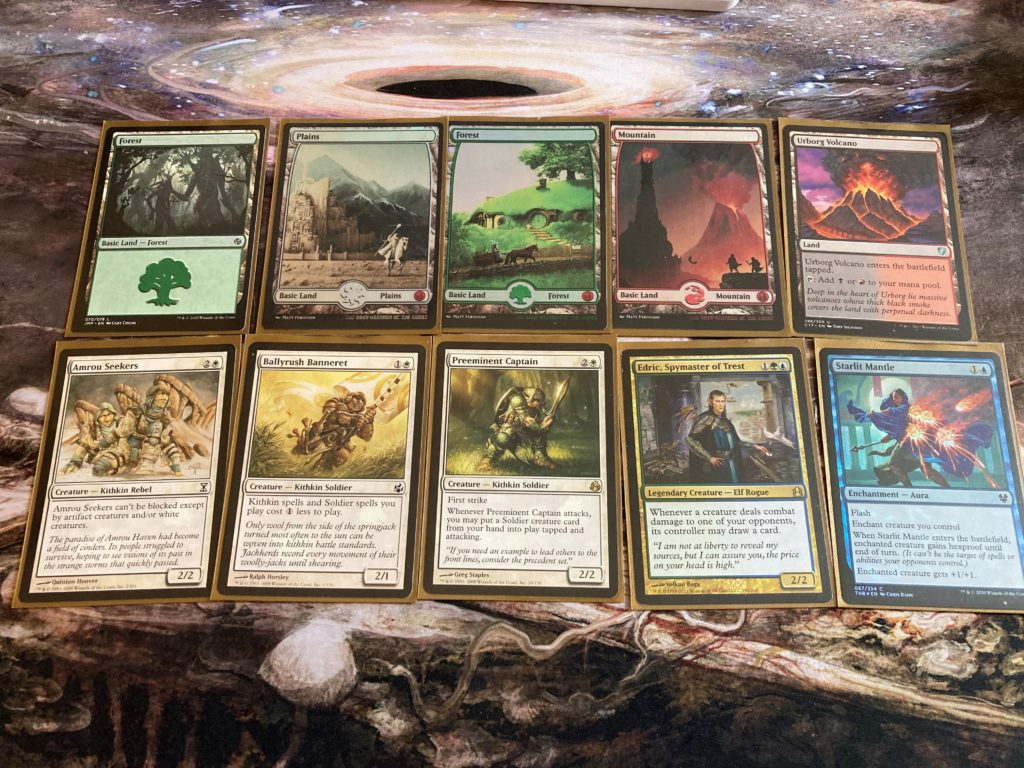
Thanks to some wonderful alters, I have started to assemble some more thematic elements to the deck. I was super stoked to open this treefolk forest from Jumpstart, and I couldn’t say no to Urborg Volcano. Picking which Kithkin to use for the Hobbits took some time, but I’m really happy with where it came out. I particularly like how Pippin — Preeminent Captain — can drop in Faramir or Denethor. Flavor win! You can also spot Elrond and the Elven Cloak here, too.
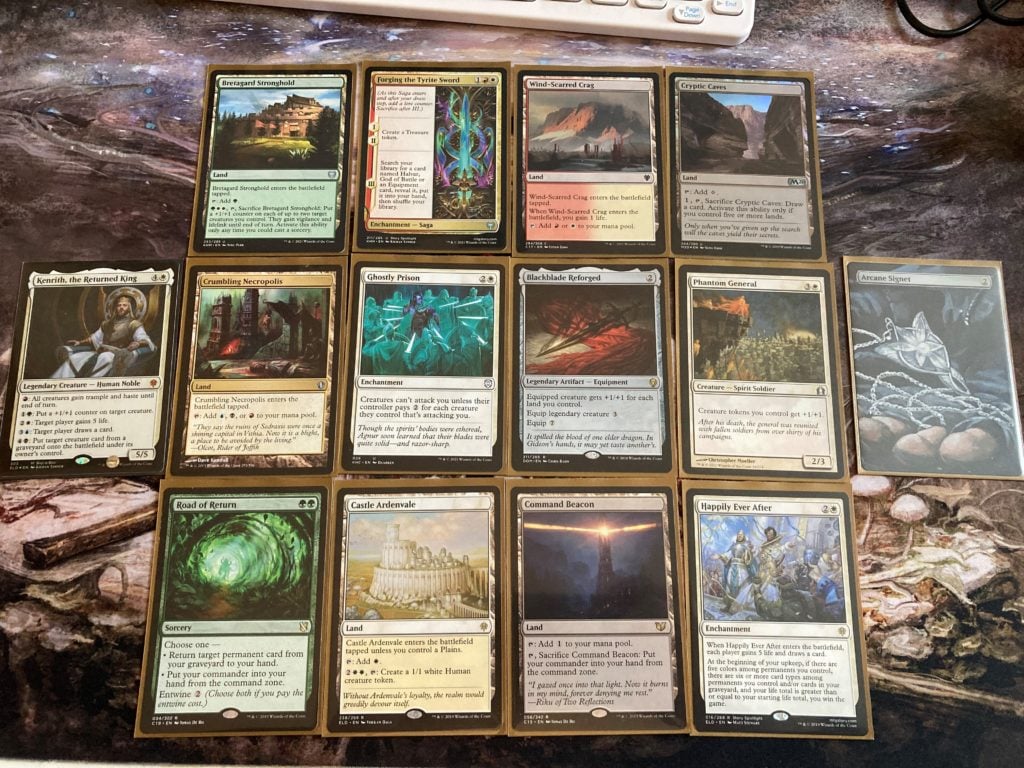
I’ve also tried to tell a story with the picks. Adding Bretagard Stronghold and Forging the Tyrite Sword has given the deck some much-needed story beats, and in the photo above, you can see Aragorn’s journey play out during the film. Happily Ever After is hard for the deck to achieve, given it only has two blue creatures — Sun Quan and Chulane as Eomer and Gandalf, respectively — but it’s worth running regardless.
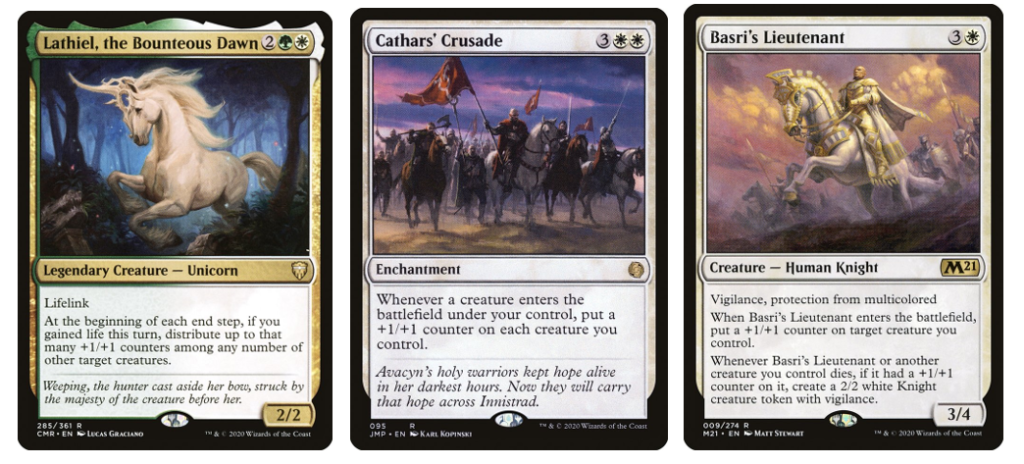
While the deck sacrifices a lot to flavor, I’ve managed to pull together two loose themes: +1/+1 counters and tokens. Lathiel — my Shadowfax — synergizes great with Kenrith’s lifegain ability, and the goal is to have lots of buffed up creatures.
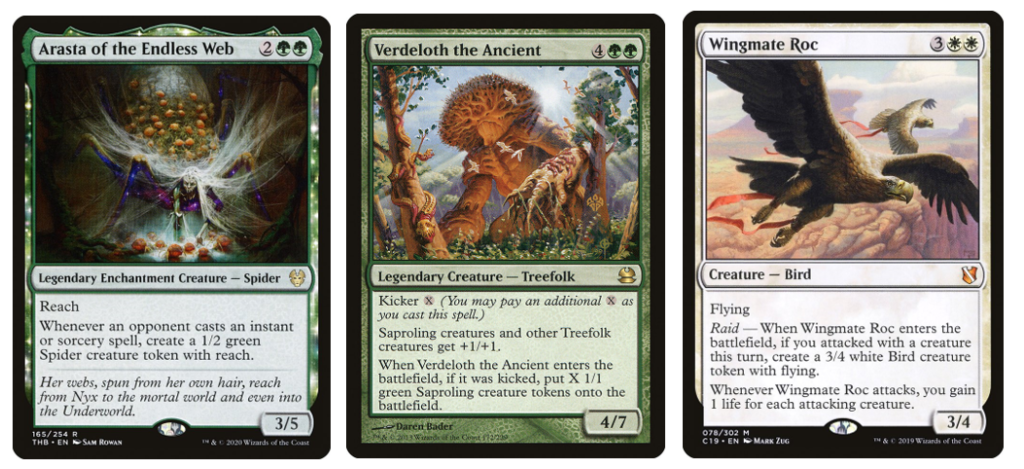
I also chose to have the other mythical beings in the deck contribute to the token strategy. From Shelob, to Treebeard, to the Eagles, they all make tokens.

Finally, a few flavor hits from a mechanics point of view. Kulrath Knight is our Nazgul on a fell beast, and it synergises very well with Kenrith; we can put counters on opposing creatures to stop them from attacking or blocking!
I’m equally enamored with Marton Stromgald as King Theoden. His fragility as a 1/1 base is analogous to his fate in the final book, but Marton’s ability to pump the team is the best “Forth, Eorlingas” you could ever want.
Oh, and did I mention that Replicating Ring can make Nine Rings for the Race of Men? Love it.
Into the West
Though part of me is a little disappointed that my life’s work making this EDH deck has been for nought, I am quietly excited for the prospect of Lord of the Rings-themed cards. Even if it’s just a standalone draftable set, I see it was a way to bring new players in in a way that isn’t too jarring to the Magic Multiverse. This could end up being a home run depending on the delivery, and I’m willing to wait and see.
How are you feeling? What did you think of my predictions for how the set might shape up? Let me know on Twitter.
I hope you enjoyed my themed Commander deck, too. Don’t forget to check out the decklist link for the lowdown on each card reference.

Kristen is Card Kingdom’s Head Writer and a member of the Commander Format Panel. Formerly a competitive Pokémon TCG grinder, she has been playing Magic since Shadows Over Innistrad, which in her opinion, was a great set to start with. When she’s not taking names with Equipment and Aggro strategies in Commander, she loves to play any form of Limited.

